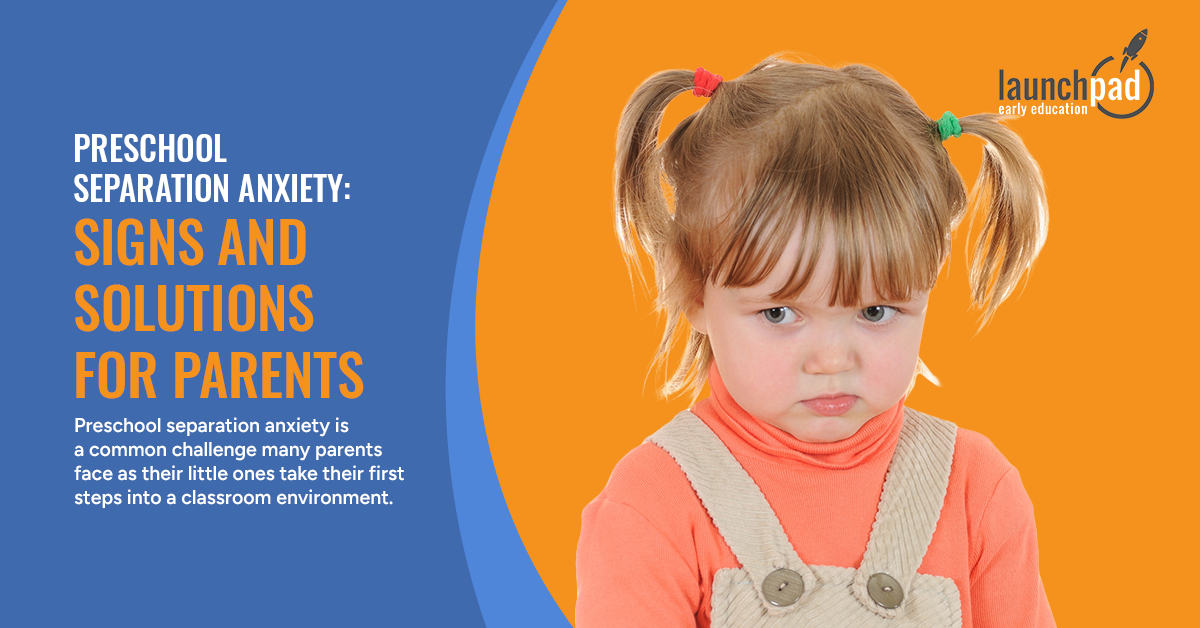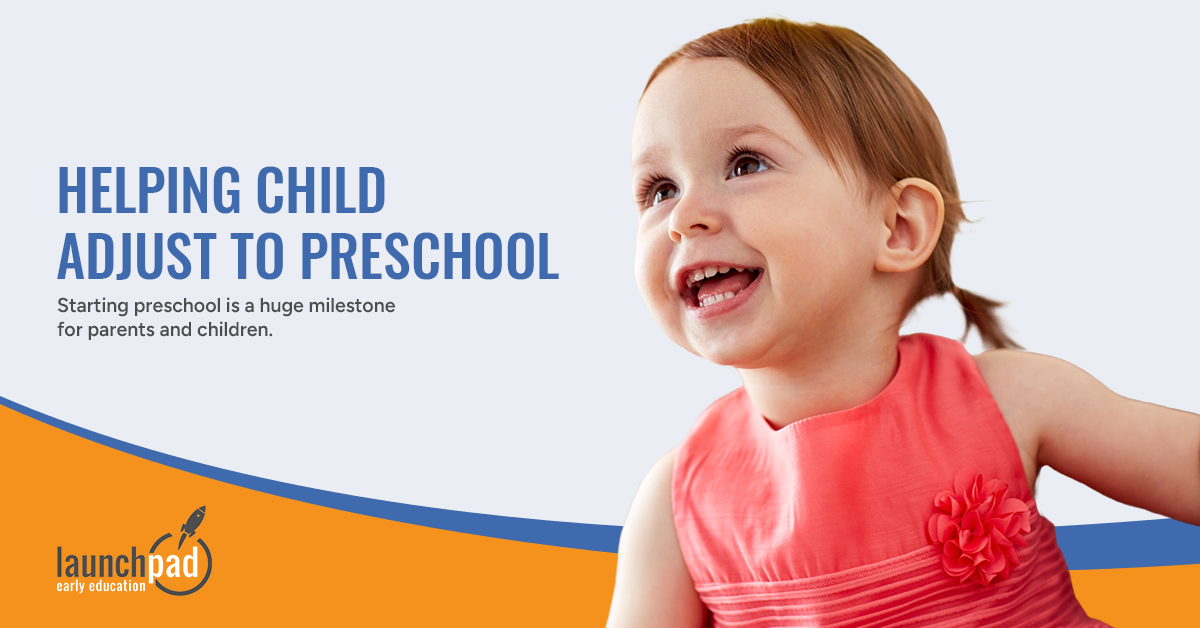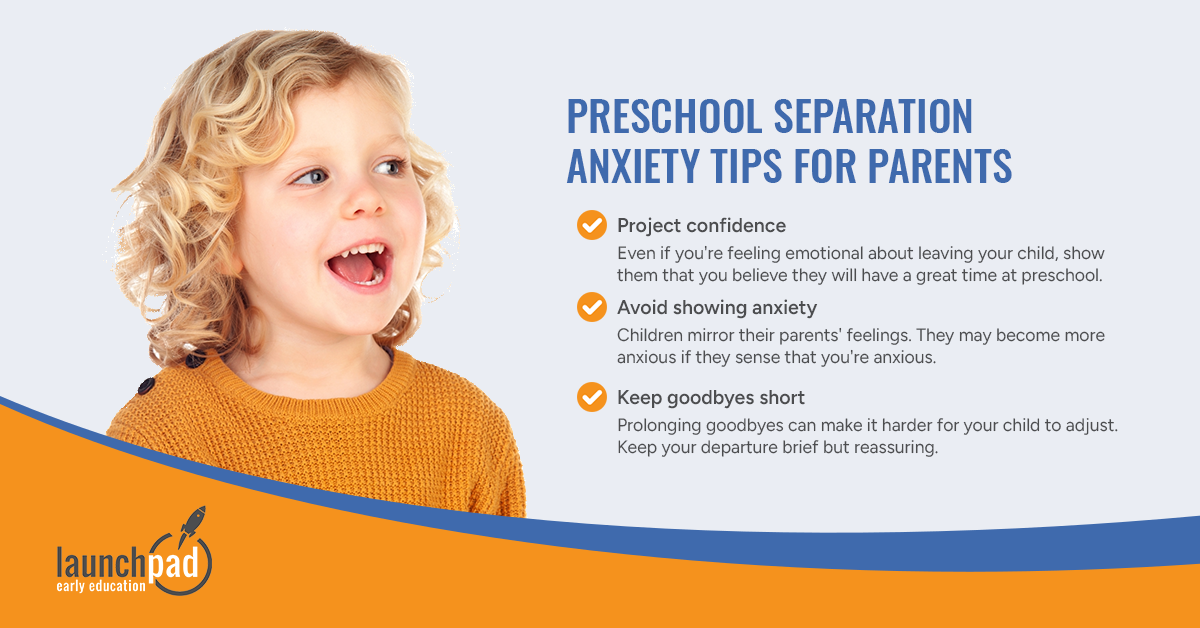Preschool separation anxiety is a common challenge many parents face as their little ones take their first steps into a classroom environment. It’s natural for children to feel nervous when saying goodbye, but it can be equally overwhelming as a parent. Understanding the signs of preschool separation anxiety and learning effective solutions can help ease the transition for you and your child.
At Launchpad EE, we know that early childhood experiences shape future learning, so we’re here to provide guidance and support through this important milestone. With a few simple strategies, you can help your child develop the confidence and independence they need to thrive in preschool and beyond.
Understanding Preschooler Separation Anxiety
Preschooler separation anxiety is a common and natural reaction when young children face a new environment, such as starting preschool. While the excitement of this milestone is undeniable, it can also bring about overwhelming emotions for a child who is accustomed to the familiarity of home. Separation anxiety refers to the emotional distress a child feels when they are separated from their parent or caregiver, especially during significant transitions like entering preschool.
Common Signs of Preschooler Separation Anxiety
It’s essential to recognize separation anxiety early, as this will help you better understand how to support your child through the transition. Here are some common behaviors that indicate separation anxiety:
- Crying or tantrums when the parent or caregiver prepares to leave
- Clinging behavior, refusing to separate from the parent
- Fearful expressions, such as worrying that something terrible will happen at preschool
- Refusing to go to school or pretending to be sick (e.g., complaints of headaches or stomachaches)
- Changes in sleep or appetite, such as difficulty falling asleep or loss of appetite
These signs can range from mild to more intense, depending on your child’s personality and how they react to new situations.
Why Does Preschool Separation Anxiety Occur?
Separation anxiety is a normal part of early development, often arising when a child faces unfamiliar surroundings. Understanding the underlying causes can help you approach the situation with empathy and reassurance. Here’s why separation anxiety happens:
- Fear of the unknown: Children are entering a new environment with unfamiliar faces and routines.
- Inability to understand time: Young children often struggle with the concept of time, making it hard for them to grasp when or if their caregiver will return.
- Emotional development: Separation anxiety is part of a child’s emotional growth and typically peaks between 18 months and 3 years, though it can reappear during significant transitions like starting preschool.
How Long Does Preschool Separation Anxiety Last?
The duration of separation anxiety varies from child to child, but most children adjust to preschool over time. Here’s what to expect:
- Temporary phase: For some children, separation anxiety may last only a few days or weeks as they adapt to the new routine.
- Longer adjustment: Others may take weeks or months to overcome the anxiety.
- Consistency is key: Establishing a steady routine and providing reassurance will help your child gradually feel more secure.
With time, patience, and understanding, your child will likely develop the confidence they need to thrive in their new preschool environment.
Helping Child Adjust to Preschool
Starting preschool is a huge milestone for parents and children. While it’s an exciting time, it can also bring about anxiety and stress for your little one. Helping your child adjust to preschool involves a combination of preparation, reassurance, and patience. With the proper techniques, you can ease the transition and set the stage for a positive preschool experience.
Establish a Consistent Routine
Children thrive on routine, and establishing one can make a world of difference when preparing your child for preschool. Here are a few ways to create a predictable schedule:
- Set a morning routine: Start practicing the school morning routine a few weeks before preschool begins, including wake-up time, breakfast, and getting ready.
- Create a bedtime routine: Ensure your child is well-rested by setting a consistent bedtime that allows for plenty of sleep. A well-rested child is more likely to cope with new experiences.
- Practice the goodbye routine: Consistency in how you say goodbye helps your child feel secure. Develop a quick, positive farewell ritual that they can rely on.
By sticking to a regular schedule, your child will feel more prepared and less anxious about the changes preschool brings.
Visit the Preschool Ahead of Time
Familiarizing your child with the preschool setting beforehand can reduce anxiety on the first day. Here are some effective strategies to do this:
- Take a tour: Arrange a visit to the preschool so your child can see the classrooms, meet the teachers, and explore the space.
- Attend an orientation: Attend any open house or orientation events if available. This helps your child get used to the idea of preschool as a fun and exciting place.
- Practice drop-offs: In the days before preschool, practice short separations by leaving your child with a trusted caregiver for brief periods.
These small steps can help your child become more familiar with the preschool setting, making the first day easier.
Stay Positive and Reassuring
Your attitude has a big impact on how your child feels about preschool. By staying positive and calm, you can help alleviate their fears. Here are some helpful tips:
- Talk about preschool positively: Focus on the fun aspects of preschool, like making new friends, playing with toys, and doing fun activities.
- Acknowledge their feelings: Let your child know it’s okay to feel nervous or sad about starting preschool. Validate their emotions, but reassure them that they will be okay.
- Stay calm during goodbyes: Avoid lingering or showing signs of distress during drop-offs. A quick, upbeat goodbye gives your child confidence and signals that preschool is a safe and happy place.
Helping your child adjust to preschool requires patience, encouragement, and consistency. These strategies can ease the transition and help your child feel excited and ready for this new adventure.
Preschool Separation Anxiety Tips for Parents
Dealing with preschool separation anxiety can be a challenging time for both parents and children. However, there are efficient strategies that parents can use to ease the transition and help their little ones feel more secure. By remaining calm, supportive, and consistent, you can minimize the emotional stress of separation and create a positive experience for your child.
Stay Calm and Confident
Children often pick up on their parents’ emotions, so staying calm and confident during drop-offs is essential. Here’s how you can maintain a composed demeanor:
- Project confidence: Even if you’re feeling emotional about leaving your child, show them that you believe they will have a great time at preschool.
- Avoid showing anxiety: Children mirror their parents’ feelings. They may become more anxious if they sense that you’re anxious.
- Keep goodbyes short: Prolonging goodbyes can make it harder for your child to adjust. Keep your departure brief but reassuring.
A confident, calm attitude will help reassure your child that preschool is a safe and enjoyable place.
Create a Consistent Goodbye Ritual
A familiar and predictable goodbye ritual can help ease your child’s anxiety and make the transition smoother. Consider these ideas:
- Develop a quick routine: Whether it‘s a special hug, a high-five, or a wave from the window, a consistent goodbye routine gives your child something to look forward to.
- Stay positive: End your goodbye with an encouraging message like, “Have fun! I can’t wait to hear about your day.”
- Stick to the routine: Consistency is key. Perform the same goodbye routine each day to build your child’s confidence and comfort.
Goodbye rituals provide reassurance and stability during a time of uncertainty for your child.
Offer Comfort Items
Sometimes, a tangible item can provide comfort and help your child feel more secure in an unfamiliar environment. Here are a few suggestions:
- Bring a transitional object: A favorite stuffed animal, small blanket, or family photo can offer your child a sense of home while at preschool.
- Talk about the object’s “job“: Explain that the comfort item’s role keeps them company while at school.
- Gradually phase it out: As your child becomes more comfortable, they may not need the item as much. You can slowly reduce their reliance on it.
These familiar objects can make the transition easier by providing a comforting connection to home.
Practice Separation at Home
If your child struggles with separation anxiety, practicing short separations at home can help them build confidence. Here’s how to get started:
- Start with brief separations: Leave your child with a trusted caregiver for short periods, gradually increasing the time apart.
- Talk about it: Explain that you’ll be back soon, just like when they go to preschool, and follow through on your return.
- Celebrate their bravery: Acknowledge when your child handles separation well to reinforce positive behavior.
These practice sessions can help your child become more comfortable being away from you.
Communicate with the Preschool Teachers
Building a partnership with your child’s preschool teachers can make a big difference in easing separation anxiety. Consider these steps:
- Share your concerns: Talk to the teacher about your child’s anxiety and work together on strategies to help them adjust.
- Establish a communication plan: Check in regularly with the teacher to stay informed about your child’s progress and behavior.
- Encourage positive interactions: Ask the teacher to help your child engage with other children and activities to distract them from their anxiety.
Working closely with the preschool staff can create a supportive environment for your child’s transition.
Conclusion
Preschool separation anxiety may seem daunting, but with the right approach, it’s a hurdle that both you and your child can overcome. By understanding the signs, preparing with consistent routines, and offering plenty of reassurance, you’ll help your little one gain confidence and independence in their new environment. Remember, this is a normal part of early childhood development, and with time, patience, and support, your child will thrive in preschool and beyond. The key is to stay cheerful and focus on the exciting new adventures awaiting your child!
If you’re looking for more guidance or resources to help your child adjust to preschool, contact Launchpad EE. We’re here to support you every step of the way! Visit us at Launchpad EE or call us at (615) 809 2211 for expert advice and support. Let’s embark on this journey together!




